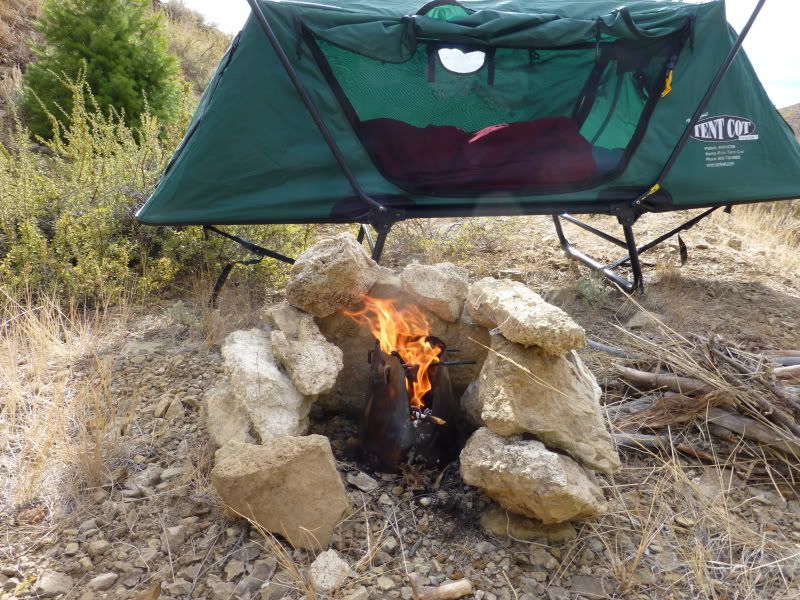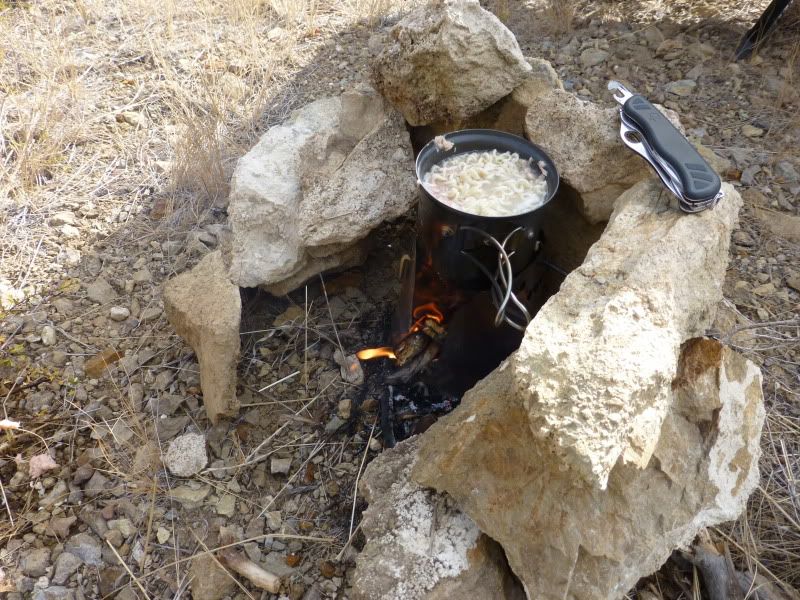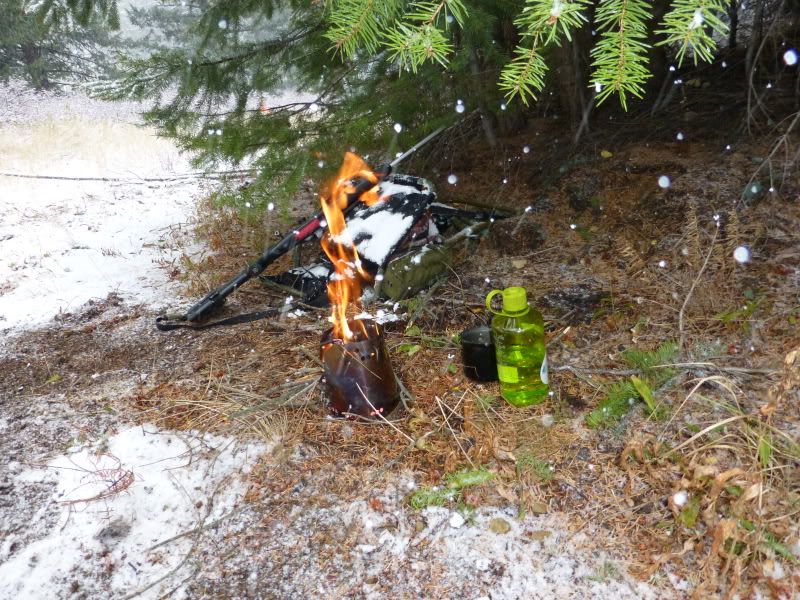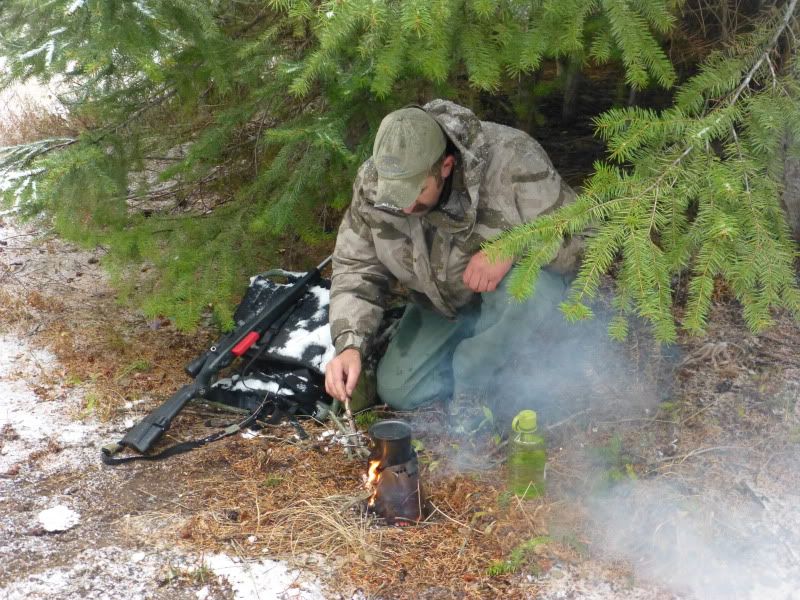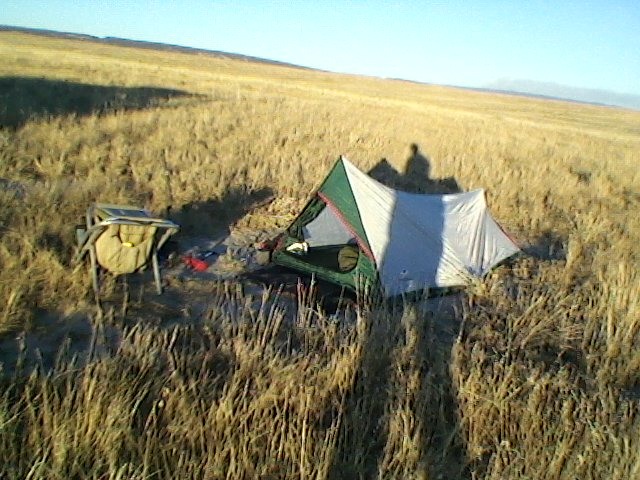those metal bottles that look like sig bottles. he told us that he kept the pump attached to the bottle at all times and that the pump at some point started to leak in the pack.
I had my MSR Firefly stove with pump attached to fuel bottles, with fuel and empty for 25 years and never had a single drop a fuel leak out. For a precaution, the fuel bottle was carried on the outside of my pack in a pouch.
I like the MSR Whisperlite. Been using it and similar stoves since the early 70s in extremely cold (sub zero) temps. I've found white gas works best in cold weather. Usually carry it in the MSR fuel bottles and never had one leak. But I do check the O rings and replace them every now and then. Sterno/Wool and such never worked for me, propane or butane freezes at sub-temps. Sterno/Wood doesn't but I like to bring my stove in my little mountain tent to take the chill off.
When I stop for the night I fire up my Whisperlite to heat my coffee/dinner, then crawl in the tent. I put some small rocks in a pan, bring the stove in the tent, and heat up the rocks. This also warms up the tent so I can get undress. I put the heated rocks in my shoes put them outside, then turn off the stove and set it outside the tent, but with in reach.
Come morning I can fire up the stove just outside the door of the tent and heat my coffee. Then bring the stove in for a minute to warm up the tent so's I can get dressed in comfort.
The rocks from the night before has my boots dried out.
I love winter camping but I like my comforts also.
I have to disagree with isopro fuel stoves commonly called cartridge stoves use in winter if these are what are being referred too. Propane in my grill outside works very well in the winter for grilling. For those who say they have issues with these stoves, they did know how to use one in the cold. I used my MSR Superfly with hanging kit down to -40 and it worked just fine. Once you screw the fuel cartridge on the stove, flick your Bic and run the flame under the fuel can for 5-10 seconds. Open the valve on the stove, light the stove and instant heat. When the stove starts to sputter, run the flame again under the fuel can. Isopro cartridge stoves are the most used stove in high altitude mountaineering all over the world. Of course the pressure at alt makes them super flame throwers, the temps are still very cold.
White gas stoves in deep cold work OK until an O ring cracks and leaks, too many small parts with O rings and seals in a white gas stove to include the pump. I have seen the plunger shrink in deep cold and pumping like crazy never built up pressure in the fuel. Parts kits are a must and trying to replace small parts at -30 is an ordeal in itself. An isopro stove side by side with a white gas stove from pack to boil will have bubbles in the boil about the same time a white gas stove is put together, pumped, primed ready to roar, isopro stove you will be drinking or eating before a white gas starts to boil.
I always used my stove with hanging kit inside my tent from first spark to pack up in the morning. It helps dry kit out, puts some heat into the body core in winter and I can lay inside my sleeping bag and dip boiling water out the pot. In the morning, reach up and spark the stove, this will get the shelter warm while boiling up hot all while I stay warm and comfy inside my sleeping bag.
In winter were liquid water is at a premium, you have to have water from snow or ice so I melt snow/ice and boil it, pour it in a bottle(s) and then place the hot bottle inside my sleeping bag at my feet with my boots also. Keeps the toes toasty all night, dries the boots and in the morning its warm enough to drink and warm the body core and then use it to melt more snow.
you can also try this one: my bag for the sleeping bag is waterproof (one of the exped compression bags,
Exped-Waterproof Compression Bags). besides the stone idea (which i like and will try),
- i turn the transport bag inside out (so that outer side is now inside)
- put my shoes inside the transport bag
- put the bag inside my sleeping bag
-> inside my sleeping bag, they won't freeze during the night. inside the transport bag they won't make the sleeping bag wet or dirty. and because i turned the bag inside-out, only the outside of the transport bag will get (if at all) dirty/wet. which i don't care about as the bag is waterproof and the dirt is easily removed with some snow/leaves.
Good idea but even in winter I would just smack the snow and ice off my boots and place them down by hot water bottles. Many times I left them out and would put them inside the sleeping bag in the AM while boiling hot.
I've never had a problem with getting a sleeping bag wet in winter camping, but I'm talking sub-zero weather. The problem is moisture from the body the bag gets overnight. What I do when I get up is turn the bag inside out, hang it up outside. The moisture freezes and can be shaken out prior to stuffing the bag in a stuff sack. This pretty much keeps it dry.
As to the stove in the tent, NO ONE is saying leave the stove on, once the stove is going, you put it in the tent for a minute or two to take the chill off so you can get undress and in the bag (you'll sleep a lot warmer in the nude then with cloths on). The stove is turned off and set just out side the opening of your tent in reach. Come morning, while still in the bag you should be able to reach the stove, and lite it while its outside, once it quits spitting and is burning right, you bring it into the tent to take the chill off so you can get dressed.
No matter how dry you think your are even in winter, yes your sleeping bad collects and stores water vapor from the body. Weigh your 3 pound down bag after a week long trip and see how much more it weighs. Weigh a 3 pound synthetic bag at the end of a week long trip and see how much more it weighs. Its surprising how much weight a down bag can gain Vs a synthetic over a week. Best option is, as you crawl out of your sleeping bag, turn it inside out and squeeze the bag hard like you are stuffing it in its sack. This will expel warm water vapor through the very open weave on the lining before it has time to liquefy and freeze inside the insulation. Sleeping bags with a black or very dark inside will use solar heat to dry laying on top of your tent even in winter temps.
I have relaxed for quite a long time in a tent and snow cave with stove roaring, even a trickle charge or two.

